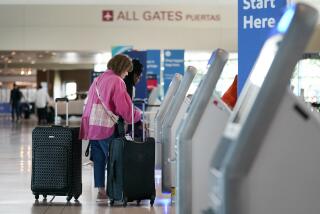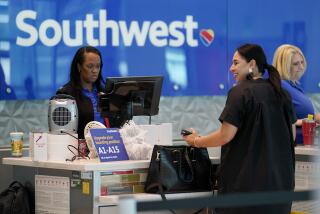Air Fare Wars Are Running Out of Fuel, Analysts Say
The price-slashing air fare war that Eric Seuthe was hoping for this winter has not come and probably never will.
Last year, the 36-year-old Los Angeles attorney paid $158 for a round-trip ticket to Salt Lake City thanks to a price war launched by financially strapped America West Airlines Inc. Today, with America West in Chapter 11 bankruptcy proceedings, Seuthe says the same trip will cost him at least $239.
“The fare wars are gone,” he said.
The era of bruising price competition, if not entirely over, is certainly fading fast. Instead of counting on 1980s-style deep discounts and $99 coast-to-coast fares, passengers should brace themselves for air fares to increase by as much as 10% this year if the economy begins to recover, according to industry analysts.
Fares have already climbed 2% this year, and United Airlines last week announced another 2% across-the-board increase for March that has been matched by several other carriers, including Northwest, USAir and Alaska Airlines.
In addition to higher regular fares, airlines have recently made it harder for passengers to take advantage of discounted tickets. Such tickets must be purchased further in advance, and the discounts are not as generous as they were last year.
Moreover, passengers may be faced with continuous price increases in the foreseeable future. Fundamental changes in the airline industry find carriers shifting strategy to compete primarily on the basis of service instead of price.
“People were given a great deal in the ‘80s,” said Harold Sirkin, a transportation consultant at the Boston Consulting Group. “But what they saw was an unreasonably low level of fares. If this March round (of fare hikes) sticks, I think we will see more of these . . . for a while.”
Despite recent price increases, some travelers are still paying less for air fares this year compared to last, a sign that the industry remains weak. As of Feb. 1, the price paid for a one-way, discount fare primarily used by leisure travelers fell 16% from last year to $125, according to the American Express Travel Airfare Index, a monthly survey of fares.
However, those fares carry the most restrictions. Meanwhile, the typical business fare rose 13% to $363, and a full coach ticket climbed 4% to $419.
Raising fares while the economy is still weak is a risky move, analysts said. An ill-timed or large increase could actually scare off passengers, erasing any gains from higher ticket prices. United and other carriers that plan to raise prices 2% in early March might also have to scuttle their plans if two other industry giants--American Airlines and Delta Air Lines--refuse to go along. Delta said it will only match the increase on discounted excursion fares popular with leisure travelers. American said it is studying the increase.
“The airlines are testing how far they can raise fares, how much effect that will have on traffic,” said Dan Kasper, director of the transportation practice at Harbridge House, a consulting firm. Kasper anticipated the average ticket price will increase about 10% this year.
The reasons for higher airline fares are a source of debate.
Industry officials say the hikes are necessary to cover their costs and recoup some of staggering $6 billion in combined losses suffered over the past two years, when the recession and Persian Gulf War mortally wounded some carriers--like Pan American Airways--and left even the healthiest air carriers bleeding red ink. Carriers also must pay for billions of dollars for new aircraft over the next decade to modernize their fleets and meet new federal noise and safety standards.
While the industry is expected to return to profitability this year, airline executives remain worried. United, which lost a $332 million last year and put off delivery of billions of dollars worth of new planes, faces massive layoffs if its financial health fails to improve, Chairman Stephen Wolf recently warned employees.
Passengers “are complaining that they are not getting the $99 fares, which are far below the operating costs of airlines,” Sirkin said. “If people price below their costs, they will go out of business.”
But covering costs is not the only reason behind rising fares, say consumer groups and industry critics.
The main reason for higher prices, critics say, is that a declining number of carriers has lessened competition and concentrated more power among the big three airlines--United, American and Delta--which already claim more than 50% of the nation’s air travel market.
“Every time we lose a carrier, it’s more and more difficult to obtain lower air fares,” said Christopher Witcowski, director of the Aviation Consumer Action Project, a consumer group founded by Ralph Nader. “The lack of competition is making it very tough” for the traveling public, he said.
While fare wars are diminishing, service looks to become the next battleground. Glossy airline ads feature plush leather seating, personal video screens and French champagne for business-class and first-class travelers. Prices, however, are not mentioned.
Although expensive, airlines are not expected to discontinue using popular frequent-flyer programs to build customer loyalty without cutting fares.
“It sounds like a return to the days (before) deregulation when they were basically competing against each other based on how many drinks you got in business class and what kind of movie they were showing,” Witcowski said.
So far, airline officials say they are pleased with the results of the 2% price hike in January, despite a report by the Air Transport Assn., an industry group, that domestic passenger traffic declined 3.1% last month.
“The clients have already noticed the increase, but 2% is not going to stop them from making a business trip, “ said Thomas Nulty, president of Associated Travel Management, a Santa Ana travel agency. “It has not slowed business down at this point.”
Airline passengers themselves seemed resigned to the coming fare hikes, but some have resolved to take greater advantage of available discounts.
“If I can plan to take a particular trip so I can take advantage of the discount fare--I do,” said Mission Viejo attorney Gene Gambale, who figures he cut the price of a $700 coast-to-coast round trip by staying over a Saturday night.
Dianne Pfanner, an oil company marketing analyst from Los Angeles, is sympathetic to the plight of the airlines.
“The past years have been crazy for them,” said Pfanner after purchasing a trip to Portland, Ore., earlier this week at a United ticket office in downtown Los Angeles. “It’s been better than a good value. They have been giving it away.”
Air Fare Ups and Downs
After falling last year, airline fares are expected to increase by 10% or more in 1992. Despite across-the-board price increases implemented earlier this year, some fares remain below 1991 levels.
Average One-Way Fares in 100 U.S. Markets
Type of fare One-way price One-way price One-way price Feb. ’92 Jan. ’92 Feb. ’91 Full Coach $419 $418 $403 Typical Business $363 $400 $320 Lowest Discount $125 $130 $149
Fares are based on an average price of one-way domestic flights in 100 U.S. cities. Specific routes were not surveyed. Overall Cost of Travel Fell Last Year
Travel Services & Products Annual % Change Jan. 1991 to Jan. 1992 Transportation -9.1 Airline fares -6.3 Other intercity transport 1.5 City public transport 7.0 Motor fuel -12.7 Lodging 5.3 Food and beverages away from home 3.0 Entertainment 4.3
Sources: American Express Airfare Management Unit, U.S. Travel Data Center and U.S. Bureau of Labor Statistics.
More to Read
Sign up for The Wild
We’ll help you find the best places to hike, bike and run, as well as the perfect silent spots for meditation and yoga.
You may occasionally receive promotional content from the Los Angeles Times.






